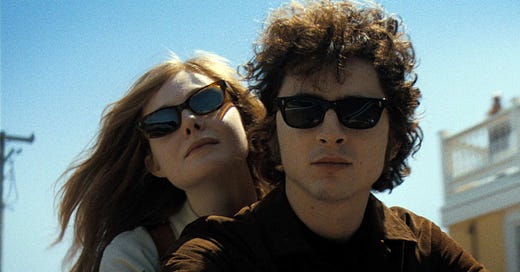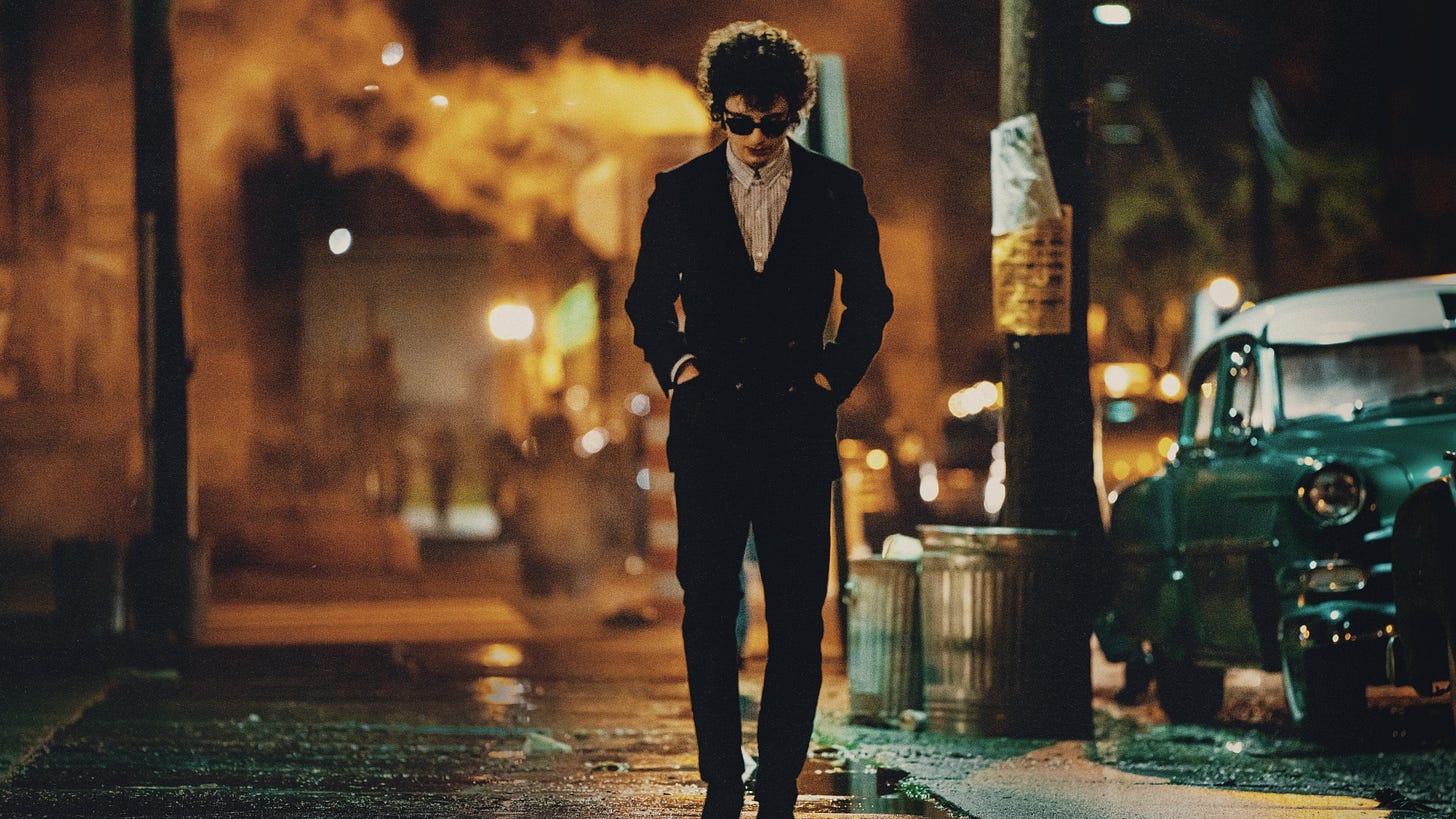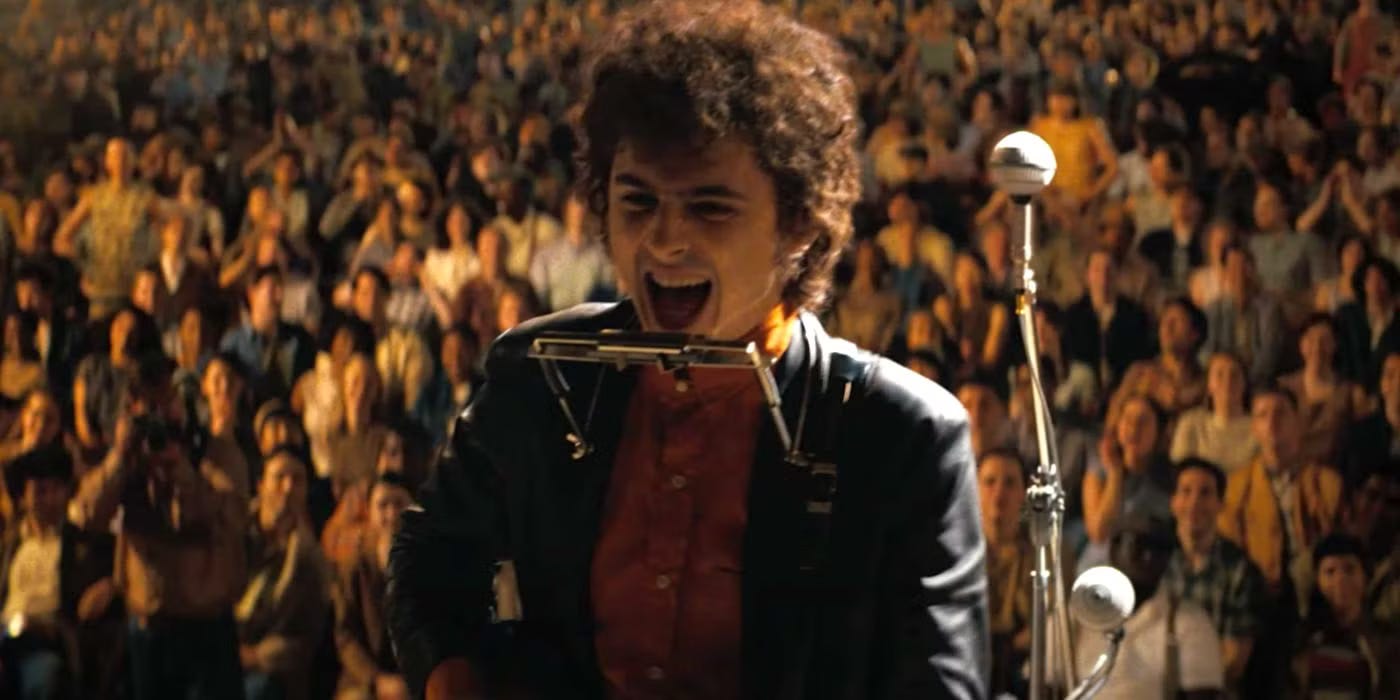Of all the traveling minstrels from this place and that, Bob Dylan holds a special place in music history and especially in folk music lore. The nasally individual of Ashkenazi descent from Duluth, Minnesota with a voice that sounds like it should be coming from a lily pad instead of a stage, is one of the most decorated and acclaimed music artists of all time. I’m not going to pretend that I am a rabid Dylan fan, but I do enjoy listening to his music after I’ve exhausted the Django: Unchained soundtrack and 1960’s surfer music just doesn’t do it for me anymore. So, without further ado, here is a very late review of a very fine biopic.
Our hero begins his story riding in the back of a family’s van on a highway traveling from New Jersey to New York in the early 1960’s. He stops at a bar where a red-faced, boisterous patron uncovers the mysteries of Communism and Catholicism with his friends. Bob asks this philosopher where he might find the Greystone Hospital where influential folk music artist, Woody Guthrie, is staying. The young man points him in the right direction and sets Dylan on his way. When Bob arrives at the hospital, he meets folk singer, Peter Seeger, crooning to Woody Guthrie at his bedside. Bob mumbles his way into an impromptu performance at Guthrie’s side and wins over both Seeger and Guthrie with his exceptional musical abilities.
Seeger allows Dylan to stay at his home with his wife, Toshi (yes, she is a daughter of the Orient), and their numerous children. Seeger, very impressed by Bob’s penchant for captivating lyrics, takes him to an open mic night at a local bar. It is here where he wows the crowd and meets Joan Baez for the first time. I don’t know about you folks, but I had never heard of Joan Baez until this movie came out. Apparently, she was a an influential singer in the 1960’s and was a major player in the civil rights movement and anti-war protest movements. She was also inducted into the Rock ’N Roll Hall of Fame in 2017. Anyway, Bob meets her at the open mic night, but almost immediately after this he meets a White girl named Sylvie at a Black church revival and the two hit it off. Sylvie and Bob quickly fall in love, but problems arise when Sylvie goes to Rome for two weeks and Bob has a tryst with Joan. Bob and Joan become an item for awhile, but then have a falling out after Joan gets mad that Bob seems to be using her (or at the very least, keeps her up at night with his guitar playing and song writing).
Amidst Bob’s lady troubles, he finds time to have a pen pal relationship with Johnny Cash. The two get to know each other and end up playing at several folk music concerts together. It is Cash who convinces Dylan to indulge his desire to play electric rock n’ roll at the Newport Folk Festival, setting us up for our finale. Seeger is strongly opposed to Bob’s proclivity for the brash, stylish sound of the electric guitar and pleads with Bob to stick to simple, folksy fare. He tugs on Bob’s heart strings with a sappy, cloying allegory about sand buckets and see-saws and how Bob has a shovel full of sand that he can use to tip the scales in favor of folk music. Bob shows how much he appreciates beach flavored playground analogies when he rips an electric chord with an electric guitar for his opening number at the Newport Folk Festival. Seeger panics and rushes to the sound equipment to try to destroy the technology with a hammer, but his disapproving wife steps in his way and stops him. Tiger Mom W.
Dylan continues his performance despite jeers from the audience and various unidentified flying objects being hurled at his head. After he steps off stage, he finally relents and takes an acoustic guitar from Johnny Cash and returns to the stage for an encore where he plays to the crowd’s whims with some fan favorites. The movie ends with Joan telling Bob that he won the war with the folksy foxes and that he doesn’t have to put up with their bulls*** anymore. Bob rides away from town on a motorcycle and then we cut to credits.
I am a big fan of biopics. I loved Bohemian Rhapsody (2018) and Elvis (2022). A Complete Unknown probably isn’t my favorite, but it is a tremendous story fit with incredible music. It certainly beats watching a Marvel movie or the seventeenth spin-off of the Star Wars franchise. Overall, it is a captivating story about a mercurial music legend, his struggles, his personal demons, and his unquenchable desire to create.
One of the major issues I had with the script was the forced relationship with Sylvie. One minute we are at the open mic night where Dylan is flirty like a birdy with Baez and the next minute we are at the Black church where he’s suddenly just “with” Sylvie. Sylive, who is based on Dylan’s real life girlfriend, Suze Rotolo, just become a thing. Like, that’s what has to happen instead of letting the story dictate what will happen. This becomes a major problem because Sylvie becomes a major character in the script. Sylvie is the apex of the love triangle between herself, Bob, and Baez, but she is an implanted geometrical figure when the base of the triangle, Bob and Baez would have been plenty. If that’s too wordy for you, the whole thing is simply bent out of shape. I think it would have been far more interesting to go deeper in the relationship between Bob and Joan and explore that dynamic instead of inserting the Sylvie character. Jumping from folk music to philosophy for a second, let’s polish off Ockham’s razor here. Sometimes, the simplest answer really is the best one. And, what’s simpler than a triangle? A straight line between Bob and Baez.
Another issue I had with the film were the kitschy facial expressions from Seeger and Toshi as they “discover” Bob’s prowess. This might simply be a matter of taste, but I find this is a problem endemic with biopics where some characters’ only role in a scene is to stand with mouth agape and look on with wonder as they witness the main character becoming what the audience already know they will be. This winking at the audience is cringe and it makes us just want to hold the director down and clean whatever it is that’s in his eye so it quits twitching at us. My goodness.
One thing I really enjoyed about the movie was Timothée Chalamet’s performance as Bob Dylan. Chalamet absolutely nailed it. The cadences, intonations, and mannerisms of Dylan were spot on and the singing was sublime. He probably should have won Best Actor for his portrayal of Dylan, but I’m sure Adrien Brody deserved the nod at the 2025 Oscar’s. (I haven’t seen The Brutalist and don’t want to.) There’s a funny scene where Dylan is at the open mic night and Joan is leaving and Dylan exclaims into the mic in an autistic stream of consciousness for the ages, “How about that Joan Baez folks? [pauses for audience cheers] Pretty good…and she’s pretty, and she sings pretty, maybe too pretty.” The casting for Dylan truly couldn’t have been better. Monica Barbaro’s portrayal of Baez was also very strong and attractively cunning.
I would give A Complete Unknown a 7.5/10. It was a fascinating movie with a killer soundtrack and is something I would want to watch again. Unfortunately, I can’t give it a higher score than that because there are simply too many structural issues with the script and there’s only so many “Holy crap, I think we’ve struck gold with this kid” countenance-shifting stares from Seeger and Toshi that one guy can take. Nevertheless, I’ll leave you with some fun. Some bouncy-house play-on-words for my Corner kiddos. How many roads must a man walk down before you can call him a man? Well, if the road ends at a cinema showing this movie and you have a pair of huevos, it’s just one. Because A Complete Unkown is a complete success (soyjak facial expressions notwithstanding).
Author Bio: Jake Hardin is a psychology graduate of Oklahoma State University who has worked in Catholic media as a video editor, op-ed writer, and social media manager. He has also served as a political consultant for an independent candidate. He is 5'10, 165 lbs and is addicted to zyn.






